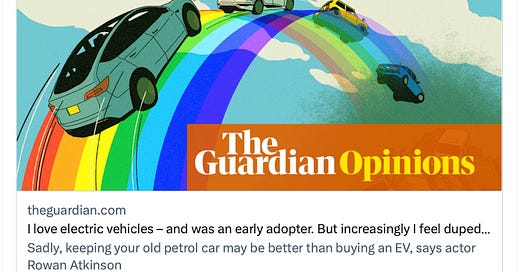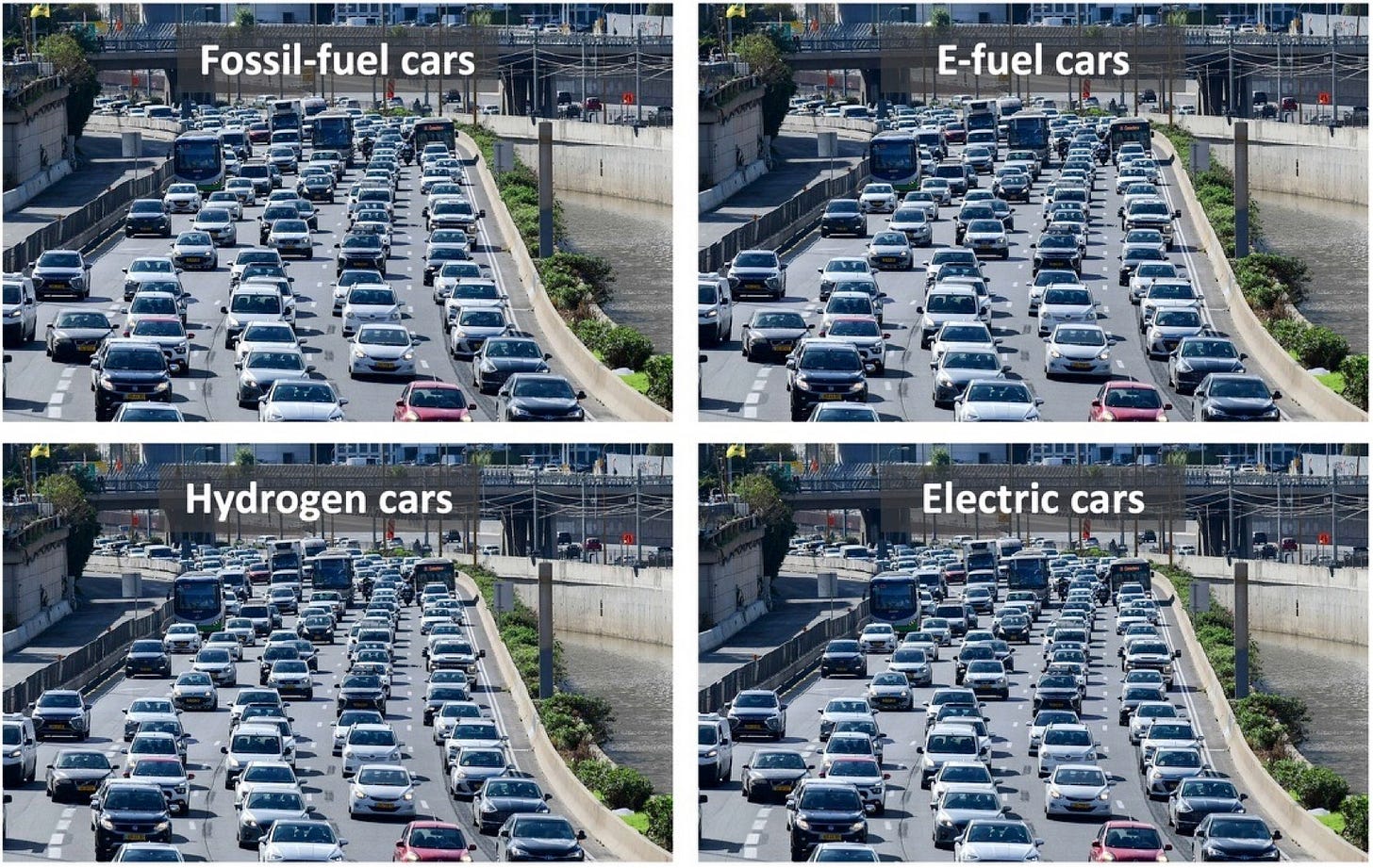The real problem with electric cars
Rowan Atkinson's article in the Guardian misses the point: we need fewer cars.
The comedian, writer and yes, electrical engineer, Rowan Atkinson wrote a controversial article in the Guardian on Saturday, in which he makes many of the arguments against electric cars that I did… five years ago. Like Atkinson, I would quote a Volvo study that put the upfront emissions from making an electric car at 70@ higher than an ICE powered car, and that it would take 9 years before an electric car’s cumulative emissions were lower than those of an ICE car. The Volvo study was discredited years ago and I have had to eat a lot of words, but it still comes up.
Key to discrediting it was electric car expert Auke Hoekstra, who does a great twitter thread explaining why Atkinson is wrong. But I am still not a fan of electric cars; even if they get to a point where they have the same upfront carbon emissions as an ICE powered car, which Hoekstra says will happen by 2030 (and I don’t doubt him; just this morning Bloomberg reported on a new battery chemistry from China that increases energy density by 25%.)
I wrote about my issues with electric cars in my book, The story of Upfront Carbon, to be released by New Society Publishers in early 2024. Here is an excerpt, edited for brevity:
We don’t just need electric cars, we need fewer cars.
The American Alliance for automotive innovation is excited about the future of the automobile.
“A robust auto manufacturing sector is vital to a healthy U.S. economy. Autos drive America forward by supporting a total of 10.3 million American jobs, or about 8 percent of private-sector employment. Each job for an auto manufacturer in the United States creates nearly 11 other positions in industries across the economy.”
The Alliance claims that auto manufacturing drives $1.1 trillion into the economy and is 5.5% of the nation’s Gross Domestic Product. These are vast numbers on their own, but they grossly understate the automobile’s impact on our economies. In the United States alone, 37,471 people were killed and 2,443,000 injured in car crashes in 2016 . An NHTSA study released in 2014 estimated that the loss in productivity and lives cost $1.1 trillion per year, coincidentally the same as the industry claims the industry generates.
Then there is the impact on climate, with 16% of global greenhouse gas emissions coming from the tailpipes of cars and trucks. This will fall quickly as vehicles are electrified, but it doesn’t address the problem of the upfront carbon emitted while building all those automobiles.
We don’t know the exact upfront carbon of electric cars, but we can do a rough approximation from lifecycle analyses prepared by Tesla and the International Council on Clean Transportation (ICCT). The best number we get is that the manufacturing phase of an average US Model 3 has a carbon footprint of 52 grams per mile driven, and the average mileage of an American car is 200,000 miles, giving us a total upfront carbon emissions of 10.4 tonnes. Running the numbers for an F-150 Lightning, we get 21.244 tonnes, slightly over twice that of the Model 3.
A small European or Chinese car is probably around 8 tonnes, so for this exercise, let’s pick a worldwide average of 10 tonnes for easy math. In 2021, there were 80 million motor vehicles built worldwide, of which 21 million were built in China. If we pretend they are all electric, that’s 800 million tonnes or 0.8 gigatonnes of upfront carbon emissions. Yet to stay under the 1.5-degree carbon budget ceiling, emissions must drop to 20 GT per year by 2030. If we plan to replace all of the 1.4 billion gasoline-powered cars on the road worldwide, we get upfront carbon emissions of 14 gigatonnes. The remaining carbon budget estimated at the start of 2023 was about 260 Gt CO2, so just the making clean cars eats up 5% of the remaining budget. If they are all SUVs and pickups, it eats up 10%. And we still have to find about 4500 kWh of zero-carbon electricity to run each of them for a year. This is why electrification may save the auto industry, but it doesn’t save the climate.
This is a fundamental problem when it seems that the entire world depends on the auto industry. It’s not just the vehicles but the roads they drive on, the parking garages they sit in, the sprawling development they make possible, the hospitals they fill, and even the police state that evolved because of them. The car isn’t just a big part of the economy, but it often seems that it is the economy.
There are many ways they can cut the upfront carbon emissions of manufacturing; The Swedish electric car manufacturer Polestar is promising a climate-neutral car by 2030 using HYBRIT steel made with hydrogen and zero-carbon aluminum made with inert anodes. A McKinsey study claims that the industry could reduce upfront carbon emissions by 66% at no extra cost, using recycled materials, green aluminum and renewable energy.
But coal-free aluminum and steel are decades away in the US and China, and if the issue of upfront carbon is on the industry’s radar, it is very far away.
The cars all have to drive on roads, which are often made of concrete. Even when they are topped with asphalt, the roadbeds underneath are made of cement-stabilized gravel. In China alone, infrastructure construction in 2016 pumped out about 250 million tonnes of CO2. The American Way is to pretend to reduce carbon emissions by adding lanes to highways with infrastructure investment, even though it is proven that more highways attract more vehicles through induced demand, and they rarely calculate the upfront emissions.
This is why we don’t just need electric cars, we need fewer cars.
Readers may complain that I am barely mentioning the fact that in their full lifecycle, electric cars have vastly lower carbon emissions than ICE cars. But this is a book about upfront carbon, not operating emissions. We simply do not have the carbon budget for all of this. Yes, we do need electric cars, but we also need a lot fewer cars and the infrastructure that supports them. As Matthew Lewis of California YIMBY notes,
“At this stage, if electric vehicles are to play a major role in solving the climate crisis — which they must — they have to be paired with dramatic land use reform that shortens or eliminates a substantial portion of all vehicle trips, and replaces them with transit, walking, biking, shared vehicles, and other forms of mobility. Only by combining a rapid deployment of electric vehicles with an equally rapid elimination of the need for most Americans to own and drive a personal vehicle in the first place can we have a shot at climate stability.”
The Automobile manufacturers say, “The personal automobile allows people to live, work and play in ways that were unimaginable a century ago.” This is true, but it is not necessarily a good thing. The manufacturers call cars a liberating technology, but it is the opposite, chaining us to a high-carbon lifestyle where we are dependent on the car for access to markets, to doctors, to jobs. As Lewis notes, we have to reimagine how we live now so that we don’t have to depend on a car for every trip.





As you have said over and over, it is about an urban zoning that does not require cars. Car centric development is not liberation, it is the continuing loss of money, time, community, loneliness, welcoming, attractive community, separation, exercise, companionship, commonly shared community spaces, walkability etc etc.
I wish out here in the boonies, that we could get behind public transport. Poor rural people as a part of carbon pollution I bet are some of the worst in contributing to climate change. There is some weird thing against it and every damn body has to have a car.